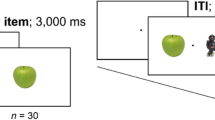Abstract
“Weapon focus” refers to the concentration of acrime witness's attention on a weapon, and the resultant reduction in ability to remember other details of the crime. We examined this phenomenon by presenting subject-witnesses with a series of slides depicting an event in a fast-food restaurant. Half of the subjects saw a customer point a gun at the cashier; the other half saw him hand the cashier a check. In Experiment 1, eye movements were recorded while subjects viewed the slides. Results showed that subjects made more eye fixations on the weapon than on the check, and fixations on the weapon were of a longer duration than fixations on the check. In Experiment 2, the memory of subjects in the weapon condition was poorer than the memory of subjects in the check condition: In Experiment 1 similar, though only marginally significant, performance effects were obtained. These results provide the first direct empirical support for weapon focus.
Similar content being viewed by others
References
Antes, J. R. (1974). The time course of picture viewing.Journal of Experimental Psychology, 103, 62–70.
Deffenbacher, K. A., & Loftus, E. F. (1982). Do jurors share a common understanding concerning eyewitness behavior?Law and Human Behavior, 6, 15–30.
Easterbrook, J. A. (1959). The effect of emotion on the utilization and organization of behavior.Psychological Review, 66, 183–201.
Gould, J. D. (1969).Eye movements during visual search (Research report No. RC2680). Yorktown Heights: IBM Thomas J. Watson Research Center.
Johnson, C., & Scott, B. (1976). Eyewitness testimony and suspect identification as a function of arousal, sex of witness, and scheduling of interrogation. Paper presented at the American Psychological Association Annual Meeting, Washington, D.C.
Loftus, E. F. (1979).Eyewitness testimony. Cambridge, MA: Harvard University Press.
Loftus, G. R., & Mackworth, N. H. (1978). Cognitive determinants of fixation location during picture viewing.Journal of Experimental Psychology: Human Perception and Performance, 4, 565–572.
Malpass, R. S., & Devine, P. G. (1984). Research on suggestion in lineups and photospreads. In Wells, G. L., & Loftus, E. F. (Eds.),Eyewitness testimony: Psychological perspectives. Cambridge, MA: Cambridge University Press.
McCloskey, M., & Egeth, H. E. (1983). Eyewitness identification: What can a psychologist tell a jury?American Psychologist (May), 550–563.
Smith, J. E. K. (1976). Data transformations in analysis of variance.Journal of Verbal Learning and Verbal Behavior, 15, 339–346.
Taylor, L. (1982).Eyewitness identification. Charlottesville, VA: The Michie Co.
Wells, G. L., Leippe, M. R., & Ostrom, T. M. (1979). Guidelines for empirically assessing the fairness of a lineup.Law and Human Behavior, 3, 285–293.
Yarmey, A. D., & Jones, H. P. T. (1983). Is eyewitness identification a matter of common sense? In S. M. A. Lloyd-Bostock & B. R. Clifford (Eds.),Evaluating witness evidence, London: Wiley.
Author information
Authors and Affiliations
Additional information
The present research was supported by grants from the National Science Foundation, and from the National Institute of Mental Health. We thank Heide Prange and Dale Peters for their many research efforts in connection with this project.
About this article
Cite this article
Loftus, E.F., Loftus, G.R. & Messo, J. Some facts about “weapon focus”. Law Hum Behav 11, 55–62 (1987). https://doi.org/10.1007/BF01044839
Issue Date:
DOI: https://doi.org/10.1007/BF01044839




